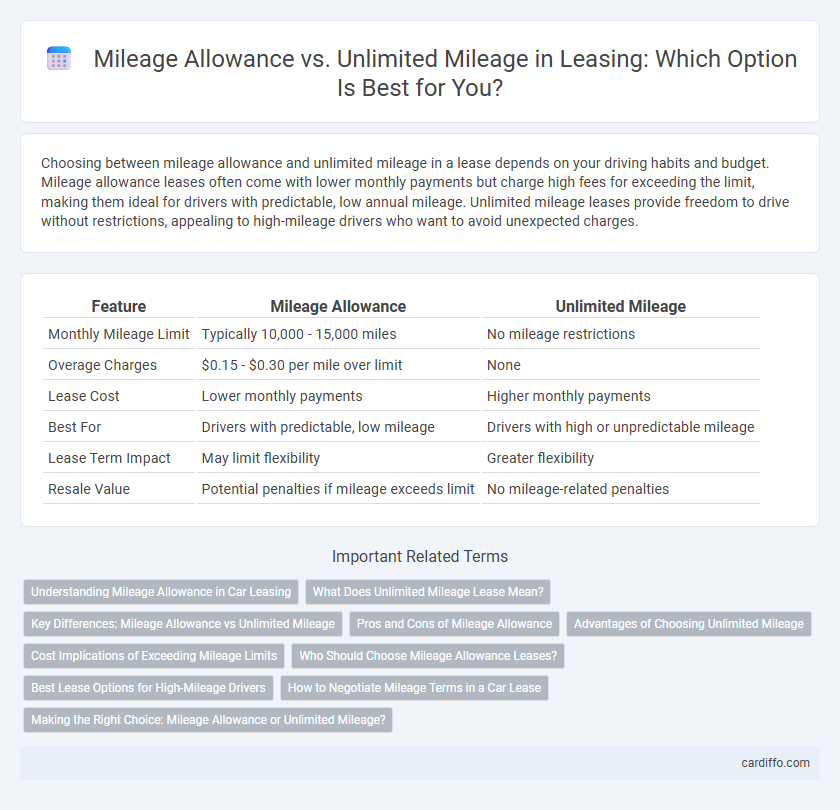Choosing between mileage allowance and unlimited mileage in a lease depends on your driving habits and budget. Mileage allowance leases often come with lower monthly payments but charge high fees for exceeding the limit, making them ideal for drivers with predictable, low annual mileage. Unlimited mileage leases provide freedom to drive without restrictions, appealing to high-mileage drivers who want to avoid unexpected charges.
Table of Comparison
| Feature | Mileage Allowance | Unlimited Mileage |
|---|---|---|
| Monthly Mileage Limit | Typically 10,000 - 15,000 miles | No mileage restrictions |
| Overage Charges | $0.15 - $0.30 per mile over limit | None |
| Lease Cost | Lower monthly payments | Higher monthly payments |
| Best For | Drivers with predictable, low mileage | Drivers with high or unpredictable mileage |
| Lease Term Impact | May limit flexibility | Greater flexibility |
| Resale Value | Potential penalties if mileage exceeds limit | No mileage-related penalties |
Understanding Mileage Allowance in Car Leasing
Mileage allowance in car leasing sets a fixed limit on the number of miles you can drive annually, typically ranging from 10,000 to 15,000 miles, with excess miles incurring additional fees. Understanding the mileage allowance is crucial to avoid costly charges at the end of the lease term and to select a plan that aligns with your driving habits. Lease agreements with unlimited mileage remove these restrictions, often resulting in higher monthly payments but offering greater flexibility for high-mileage drivers.
What Does Unlimited Mileage Lease Mean?
An unlimited mileage lease allows the lessee to drive without restrictions on the total miles driven during the lease term, eliminating potential excess mileage fees. This type of lease provides maximum flexibility for drivers with high annual mileage, often resulting in higher monthly payments compared to standard mileage allowance leases. Choosing an unlimited mileage lease can prevent costly charges typically incurred when exceeding preset mileage limits in traditional leases.
Key Differences: Mileage Allowance vs Unlimited Mileage
Mileage allowance lease agreements set a specific limit on the number of miles you can drive annually, typically ranging from 10,000 to 15,000 miles, with excess mileage charges applied for overruns. Unlimited mileage leases remove these restrictions, allowing unrestricted travel without additional fees, which benefits high-mileage drivers or frequent travelers. The key difference lies in cost predictability and flexibility: mileage allowance leases offer lower monthly payments but risk extra fees, while unlimited mileage leases provide peace of mind at a higher monthly cost.
Pros and Cons of Mileage Allowance
Mileage allowance in lease agreements sets a fixed limit on the number of miles you can drive annually, helping to lower monthly payments compared to unlimited mileage leases. Exceeding the allowance results in costly per-mile penalties, which can significantly increase total expenses if your mileage is underestimated. This option is ideal for drivers with predictable, low-mileage habits but poses financial risks for those with variable or high mileage needs.
Advantages of Choosing Unlimited Mileage
Unlimited mileage leases offer drivers the freedom to travel without constraints, eliminating concerns over excess mileage fees that can significantly increase lease costs. This flexibility is particularly advantageous for long-distance commuters and businesses relying on frequent travel, ensuring predictable monthly payments and avoiding unexpected expenses. Choosing unlimited mileage enhances overall leasing value by providing greater convenience and financial certainty throughout the lease term.
Cost Implications of Exceeding Mileage Limits
Exceeding mileage limits on a lease typically results in costly per-mile penalties that significantly increase overall expenses compared to unlimited mileage leases. Lease agreements with mileage allowances often impose fees ranging from $0.15 to $0.30 per additional mile, leading to substantial financial impact if driving habits exceed initial estimates. Unlimited mileage leases eliminate these extra charges, providing predictable monthly payments and shielding lessees from unexpected high costs.
Who Should Choose Mileage Allowance Leases?
Mileage allowance leases suit drivers with predictable, low annual mileage, typically under 10,000 to 12,000 miles per year, aiming to avoid higher monthly payments associated with unlimited mileage plans. Businesses with defined travel limits or individuals using the vehicle mainly for commuting benefit from these leases, as they help control costs by minimizing excess mileage fees. Choosing a mileage allowance lease is ideal for those confident in their driving habits and who prefer lower upfront lease costs over flexible distance options.
Best Lease Options for High-Mileage Drivers
High-mileage drivers benefit most from lease options that offer unlimited mileage or high mileage allowances, avoiding costly penalties for excess miles. Lease agreements with unlimited mileage provide flexibility and predictable costs, ideal for those driving over 15,000 miles annually. Comparing lease terms, including mileage limits and overage fees, ensures selecting the most cost-effective plan for extensive driving needs.
How to Negotiate Mileage Terms in a Car Lease
When negotiating mileage terms in a car lease, clearly assess your average monthly driving distance to determine if a standard allowance meets your needs or if unlimited mileage is necessary. Request flexibility in increasing the mileage allowance upfront to avoid costly penalties at lease-end, and compare lease offers that provide the best mileage terms relative to your budget. Highlight your driving history and negotiate for lower excess mileage rates or waived fees to create a more cost-effective agreement.
Making the Right Choice: Mileage Allowance or Unlimited Mileage?
Choosing between mileage allowance and unlimited mileage in a lease depends heavily on your expected driving habits and financial priorities. Mileage allowance offers a lower monthly payment but incurs costly fees for exceeding the predetermined limit, making it suitable for low-mileage drivers. Unlimited mileage eliminates overage charges and provides flexibility, often at a higher upfront cost, ideal for high-mileage users seeking convenience and peace of mind.
Mileage Allowance vs Unlimited Mileage Infographic

 cardiffo.com
cardiffo.com